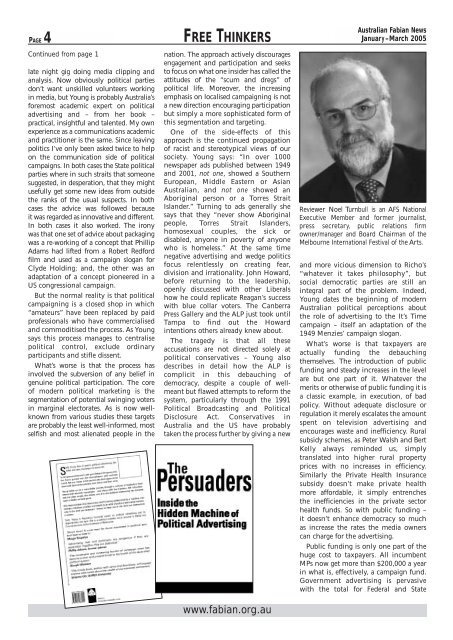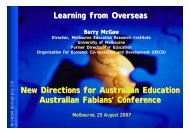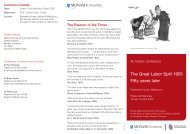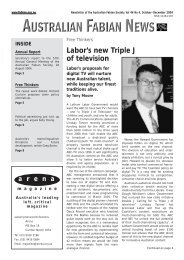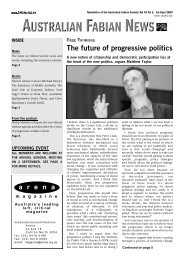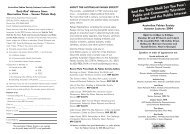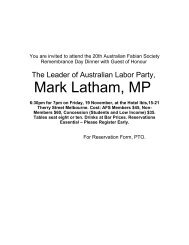Vol 45 No 1 - Australian Fabian Society
Vol 45 No 1 - Australian Fabian Society
Vol 45 No 1 - Australian Fabian Society
You also want an ePaper? Increase the reach of your titles
YUMPU automatically turns print PDFs into web optimized ePapers that Google loves.
PAGE 4Continued from page 1late night gig doing media clipping andanalysis. <strong>No</strong>w obviously political partiesdon’t want unskilled volunteers workingin media, but Young is probably Australia’sforemost academic expert on politicaladvertising and – from her book –practical, insightful and talented. My ownexperience as a communications academicand practitioner is the same. Since leavingpolitics I’ve only been asked twice to helpon the communication side of politicalcampaigns. In both cases the State politicalparties where in such straits that someonesuggested, in desperation, that they mightusefully get some new ideas from outsidethe ranks of the usual suspects. In bothcases the advice was followed becauseit was regarded as innovative and different.In both cases it also worked. The ironywas that one set of advice about packagingwas a re-working of a concept that PhillipAdams had lifted from a Robert Redfordfilm and used as a campaign slogan forClyde Holding; and, the other was anadaptation of a concept pioneered in aUS congressional campaign.But the normal reality is that politicalcampaigning is a closed shop in which“amateurs” have been replaced by paidprofessionals who have commercialisedand commoditised the process. As Youngsays this process manages to centralisepolitical control, exclude ordinaryparticipants and stifle dissent.What’s worse is that the process hasinvolved the subversion of any belief ingenuine political participation. The coreof modern political marketing is thesegmentation of potential swinging votersin marginal electorates. As is now wellknownfrom various studies these targetsare probably the least well-informed, mostselfish and most alienated people in theFREE THINKERSnation. The approach actively discouragesengagement and participation and seeksto focus on what one insider has called theattitudes of the “scum and dregs” ofpolitical life. Moreover, the increasingemphasis on localised campaigning is nota new direction encouraging participationbut simply a more sophisticated form ofthis segmentation and targeting.One of the side-effects of thisapproach is the continued propagationof racist and stereotypical views of oursociety. Young says: “In over 1000newspaper ads published between 1949and 2001, not one, showed a SouthernEuropean, Middle Eastern or Asian<strong>Australian</strong>, and not one showed anAboriginal person or a Torres StraitIslander.” Turning to ads generally shesays that they “never show Aboriginalpeople, Torres Strait Islanders,homosexual couples, the sick ordisabled, anyone in poverty of anyonewho is homeless.” At the same timenegative advertising and wedge politicsfocus relentlessly on creating fear,division and irrationality. John Howard,before returning to the leadership,openly discussed with other Liberalshow he could replicate Reagan’s successwith blue collar voters. The CanberraPress Gallery and the ALP just took untilTampa to find out the Howardintentions others already knew about.The tragedy is that all theseaccusations are not directed solely atpolitical conservatives – Young alsodescribes in detail how the ALP iscomplicit in this debauching ofdemocracy, despite a couple of wellmeantbut flawed attempts to reform thesystem, particularly through the 1991Political Broadcasting and PoliticalDisclosure Act. Conservatives inAustralia and the US have probablytaken the process further by giving a newwww.fabian.org.au<strong>Australian</strong> <strong>Fabian</strong> NewsJanuary–March 2005Reviewer <strong>No</strong>el Turnbull is an AFS NationalExecutive Member and former journalist,press secretary, public relations firmowner/manager and Board Chairman of theMelbourne International Festival of the Arts.and more vicious dimension to Richo’s“whatever it takes philosophy”, butsocial democratic parties are still anintegral part of the problem. Indeed,Young dates the beginning of modern<strong>Australian</strong> political perceptions aboutthe role of advertising to the It’s Timecampaign – itself an adaptation of the1949 Menzies’ campaign slogan.What’s worse is that taxpayers areactually funding the debauchingthemselves. The introduction of publicfunding and steady increases in the levelare but one part of it. Whatever themerits or otherwise of public funding it isa classic example, in execution, of badpolicy. Without adequate disclosure orregulation it merely escalates the amountspent on television advertising andencourages waste and inefficiency. Ruralsubsidy schemes, as Peter Walsh and BertKelly always reminded us, simplytranslated into higher rural propertyprices with no increases in efficiency.Similarly the Private Health Insurancesubsidy doesn’t make private healthmore affordable, it simply entrenchesthe inefficiencies in the private sectorhealth funds. So with public funding –it doesn’t enhance democracy so muchas increase the rates the media ownerscan charge for the advertising.Public funding is only one part of thehuge cost to taxpayers. All incumbentMPs now get more than $200,000 a yearin what is, effectively, a campaign fund.Government advertising is pervasivewith the total for Federal and State


